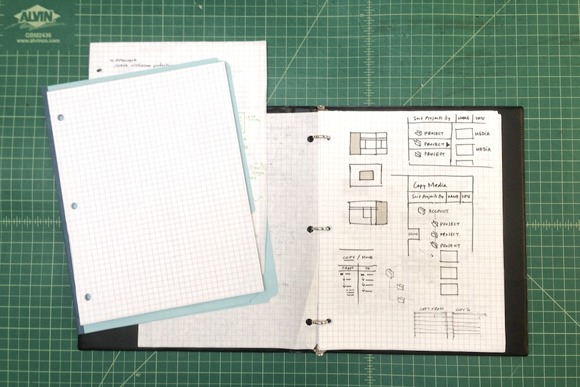I love thinking about organizational systems using notebooks, and I love seeing other people’s thoughts on the same topic. Here’s a really interesting look at one person’s perfect sketchbook system.
If you’re a serious sketchbook user, you know that it’s basically a second brain. By that, I mean it’s not just a place for recording your lists and notes and designs and schemes, it’s part of the way those things take shape. In the words of Field Notes (one of the many great-but-not-quite-perfect sketchbook brands), “I’m not writing it down to remember it later, I’m writing it down to remember it now.” Your sketchbook isn’t just a place to document your process, it is the medium of your creative process itself.
Which is why having the perfect sketchbook is so important.
Your sketchbook should go everywhere with you. It should welcome every new idea with a fresh page, be a pleasure to hold, to write in, and to search through. I’ve been through literally dozens of sketchbooks – some were abandoned immediately, others were used until they were dogeared and disintegrating. As I moved from book to book, trying new brands, new formats, new habits, I developed a set of criteria for the Ultimate Sketchbook.
1. It must be able to lay open.
As much as I like Moleskines in their various sizes and formats, I need to be able to open to a page and have it lay flat so that I can glance at, hands-free.
2. It must be letter-sized.
I love the portability of a little Field Notes book tucked in my back pocket, but the truth is I need my space. Executing a sketch at the scale of a postage-stamp is not a useful constraint.
3. It must work without a flat surface.
I need to be able to write down an idea without finding a desk to sit at, which means that the sketchbook itself must be relatively rigid and (again) large enough to hold steadily in the crook of one arm, like a clipboard.
4. It must be rugged.
Most sketchbooks run out of life before they run out of blank pages. A recent experiment with a nice Rhodia pad was going well until the cover fell off and the pages started falling out. Granted, I put my sketchbooks through a real beating, but protecting my old notes is as important as helping me take new ones.
This final point was the battlefield on which even the strongest contenders continued to fall. And that got me thinking… why do I need to keep carry all these old sketches around, anyway? It’s important to have your most recent pages for immediate reference, but did I really need to haul three months of work around with me? What if I separated the sketching from the storing?
At a bare minimum, I needed a rugged, flat, letter-sized surface that was always open and ready with a blank page. I needed some way for it to hold my most recent sketches, and I needed someplace to easily archive pages once they were no longer needed for reference. At a bare minimum, I needed a pad of paper, a folder, and a binder.
Read more at Non Sequitur Fridays: The Best Sketchbook Of All Time.
The other benefit to this system is that it’s probably a lot cheaper than most of the name brands he mentions as alternatives. This method wouldn’t be considered the “best of all time” by many other people– we all like different things. What’s your idea of the best sketchbook ever?


What a great system! And interestingly, my system is not very different. It’s basically like a large-size Midori notebook filled with watercolor paper stitched into signatures that I make myself. When the signature is full, I take it out. When I have filled six of them, I bind them all together. Here’s what the notebook looks like:
http://www.tina-koyama.blogspot.com/2013/06/travel-sketchbook-issue-resolved.html
And here’s what a finished bound book looks like:
http://www.tina-koyama.blogspot.com/2013/10/the-hand-book-binding-groove.html
– Tina